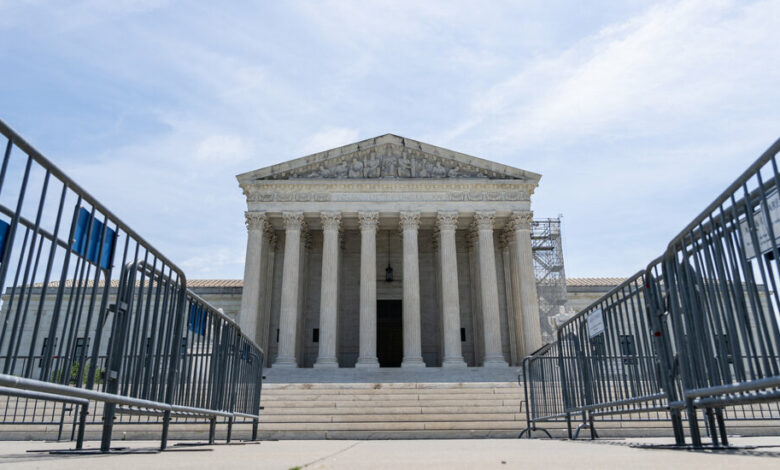In a volatile time, a broken Supreme Court has reshaped America

Former President Donald J. Trump had a very good year on the Supreme Court. On Monday, the court ruled that he is essentially immune from prosecution on charges that he tried to undermine the 2020 election. On Friday, the court threw doubt on two of the four charges against him in what remains of that prosecution. And in March, the justices allowed him to seek another term despite a constitutional provision that bars insurrectionists from holding office.
Administrative agencies had a terrible term. In three 6-3 rulings along ideological lines, the court’s conservative supermajority erased a bedrock precedent that required courts to respect agency expertise, dramatically extended the time available to challenge agency actions, and torpedoed the administrative courts through which the Securities and Exchange Commission brings enforcement actions.
The court itself has had a volatile term, taking on a dazzling series of major disputes and assuming a dominant role in shaping American society and democracy. If the justices have felt embarrassed by the backlash over their 2022 abortion decision, the lingering questions about their ethical standards and the decline in their public approval, there have been only glimpses of restraint, most notably in dodging two abortion cases in an election year.
The court was split 6-3 not only in Monday’s decision on Trump’s immunity and the three cases involving government powers, but also in a series of landmark cases involving homelessness, voting rights, guns and corruption.
An unusually high percentage of split decisions in argued cases — more than two-thirds — were decided by 6-3 votes. But only half of those decisions had the most common split, with the six Republican appointments in the majority and the three Democratic ones in the dissent.
The justices reached unanimous or lopsided rulings in other major cases, including those that kept abortion pills widely available, allowed the government to disarm domestic abusers, allowed Trump to return to the ballot in Colorado, upheld the National Rifle Association’s First Amendment rights and dismissed a complaint from the Consumer Financial Protection Bureau.
Irv Gornsteinthe director of the Supreme Court Institute in Georgetown, said the court’s liberals had, in some ways, a good term.
“But most of those victories are an artifact of so many cases coming out of the lawless Fifth Circuit,” he said, referring to the federal appeals court in New Orleans. “The judges in that circuit seem to be in a kind of competition to see who can write the most precedent-twisting, common-sense-defying decision.”
Pamela Karlana Stanford law professor, agreed, saying that “the Fifth Circuit makes the Supreme Court look more moderate than it is.”
Even when the justices agreed, they often could not find consensus on the reasoning. In fact, they issued competing opinions at a record pace, the most since at least 1937 and probably ever. Some of those opinions revealed fractures on the right, particularly over the role that history should play in interpreting the Constitution.
Gregory G. Garrea lawyer at Latham & Watkins who served as U.S. attorney general during the George W. Bush administration said there are “signs of dysfunction” among the judges.
“The court hears an extraordinarily small number of cases,” he said, “and it takes an extraordinarily long time to decide them. And the justices are increasingly writing individual opinions to express their own views. This is particularly pronounced on the right side of the court and must create some friction among the justices.”
There was a sense of disarray as the deadline expired. On Wednesday, the court briefly issued an abortion ruling and then immediately withdrew it. It would not be formally issued until the following day.
Thursday made it 13 separate corrections up to four sets of opinions. In one of themIn blocking a Biden administration plan to combat air pollution, Justice Neil M. Gorsuch had repeatedly referred to nitrogen oxide as nitrous oxide.
That confusion, Professor Karlan said, “would be funny (in a laughing gas sort of way) if the court weren’t simultaneously blasting expert bodies that do know the difference.”
A look at how individual justices voted in divided cases heard after oral arguments brings the trends at the court into sharp focus, he said. collected and analyzed data Through Lee Epstein And Andrew D. Martinboth from Washington University in St. Louis, and Michael J. Nelson from Penn State.
By that standard, the court is unusually polarized. Two of the four most conservative justices to serve since 1937 are on the current court: Justices Clarence Thomas and Samuel A. Alito Jr. (The others were Chief Justices William H. Rehnquist and Warren E. Burger.)
During the same period, two of the five most liberal justices currently serve: Justices Sonia Sotomayor and Ketanji Brown Jackson. (The others were Justices Thurgood Marshall, William J. Brennan Jr. and William O. Douglas.)
Overall, in the divided cases heard in the final term, Democratic appointees voted for a liberal outcome 83 percent of the time and for a Republican outcome 33 percent of the time. percentage point difference.
The leadership of Chief Justice John G. Roberts Jr. of the court was called into question in 2022 by his lone dissent in Dobbs vs. Jackson Women’s Health Organizationfailing to convince even one of his five conservative colleagues to join him in restricting, but not abolishing, the constitutional right to abortion.
Two years later, things appear to be looking up. He has awarded himself an unusually large share of the term’s majority opinions in the biggest cases, including those on Trump’s immunity from prosecution, the Jan. 6 prosecutions, the Second Amendment, the Chevron doctrine and administrative tribunals.
The chief justice held a majority in divided cases 94 percent of the time, more than any other member of the court, tying his own record in the term that ended in 2020. No other chief justice since at least 1953 has held a majority so often.
But it is Justice Brett M. Kavanaugh who has set the pace over time. Since joining the court in 2018, he has been in the majority 89 percent of the time, a higher percentage than any justice since at least 1953.
It wasn’t long ago that some considered Justice Thomas the true leader of the court, but the data this term belies that idea. For example, he was in the majority in divided cases only 63 percent of the time.
Last term, Justice Alito was part of the pair most likely to disagree, voting with Justice Elena Kagan only 21 percent of the time. This term, Justice Thomas was part of both pairs most likely to disagree, voting with Justices Sotomayor and Kagan only 9 percent of the time.
At the other end of the spectrum were the two justices who voted together most often: members of the court’s liberal wing, Justices Kagan and Sotomayor, at 94 percent.
A look at the three justices most likely to vote together on divided cases confirms two pieces of conventional wisdom and refutes a third. The court’s three liberals — Justices Sotomayor, Kagan and Jackson — voted together 81 percent of the time, more than any other three-justice combination. They were followed by three Republican appointments often said to represent the court’s center — Chief Justice Roberts and Justices Kavanaugh and Amy Coney Barrett — at 75 percent.
But the consensus among the other three justices, often lumped together as the court’s hard right wing — Justices Thomas, Alito and Gorsuch — was much lower, at 59 percent. That refutes the 3-3-3 court narrative and underscores Justice Gorsuch’s independence.
Indeed, he voted 45 percent of the time for liberal outcomes in divided cases, often against the government and in favor of powerless litigants. Since joining the court in 2017, he has voted for the government just 35 percent of the time, the lowest percentage of any member of the court.
When Justices Thomas and Alito were both in the majority in divided cases, Justice Gorsuch voted with them less often than any other member of the court’s conservative wing.
In other words, none of the three Trump-appointed members of the court are as conservative as Justices Thomas and Alito.
Justice Barrett, Trump’s third appointee, is certainly worth watching, Professor Epstein said. “Some indicators show that Barrett — while still much more conservative than her predecessor, Ruth Bader Ginsburg — is moving slightly to the left,” she said. “This term, she overtook Roberts as the Republican appointee who cast the highest percentage of liberal votes in divided cases.”
Mr. Trump has expressed disappointment with his choices and may be inclined to nominate more extreme justices, perhaps from the Fifth Circuit, if he gets another term. The court’s four oldest members are Justice Thomas, 76; Justice Alito, 74; Justice Sotomayor, 70; and Chief Justice Roberts, 69.
While Trump was president, his administration fared relatively poorly in the Supreme Court in signed decisions in orally argued cases in which the United States, an executive department, an independent agency, or the president himself was a party, winning only 42 percent of the time, the lowest percentage since at least the Roosevelt administration. In contrast, the Biden administration has won 54 times. percent of the time.
The term that ended Monday was packed with more potential blockbusters than ever before. The court defused a few, but the term ended with a series of earth-shaking explosions.
When the justices return in October, they will face what is, at least for now, a more typical agenda. Among the cases the court has agreed to hear are those involving transgender care for minors and so-called ghost guns.
There is little reason to believe that the court will reach consensus in these cases.
Mr. Garre said the feuding among the justices, particularly the conservative ones, was reminiscent of a comment attributed to Justice Oliver Wendell Holmes Jr., who is said to have compared the Supreme Court to “nine scorpions in a bottle.”
“Chief Justice Rehnquist once described the job of chief as akin to herding cats,” Mr. Garre said. “To borrow Holmes’s dictum, perhaps the better analogy today is herding scorpions.”




